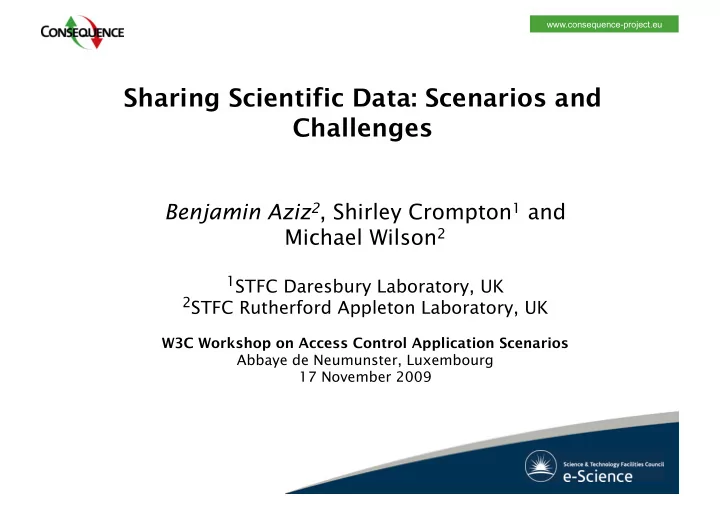

www.consequence-project.eu Sharing Scientific Data: Scenarios and Challenges Benjamin Aziz 2 , Shirley Crompton 1 and Michael Wilson 2 1 STFC Daresbury Laboratory, UK 2 STFC Rutherford Appleton Laboratory, UK W3C Workshop on Access Control Application Scenarios Abbaye de Neumunster, Luxembourg 17 November 2009
www.consequence-project.eu Science and Technology Facilities Council (STFC) Developing and supporting science facilities for the disciplines of particle physics, astronomy, microelectronics, etc. And recently medical research e-Science Centre • High performance services and applications to support scientific research • Research and development programme includes: • Large-scale intensive computing based on Grids • Semantic Web technologies • Scientific data management, including sharing & preservation
www.consequence-project.eu Objectives of this Research Work • Current situation is one of two extremes: – Mostly no sharing (when scientific studies are commercially funded) – Loose data sharing (when studies publicly funded) • But also: – Gap between high-level data sharing agreements (DSAs) with academics, funding parties and industrials, and the low-level security mechanisms enforcing these DSAs • Facilitate flexible data sharing and usage of scientific data across different administrative domains • Provide a top-to-down process in which not only system administrators and developers are involved, but also scientists, lawyers and project managers (i.e. stakeholders)
www.consequence-project.eu EU FP7 Project Consequence (2008-2010) Project Statement Partners • The aim is to fill in the gap • BAE (Test-bed owners, DSA Management) between high-level business • STFC (Test-bed owners, DSA security requirements and Management) low-level security • HP (research, DSA authoring mechanisms and mapping) • Provide a framework for • CNR (research, formal analysis) context-aware data-centric • Create-Net (research, policy security where data can be mapping) shared and processed across • Imperial College London administrative domains in a (research, enforceable policies) fine-tuned manner • EMIC (Coordinators, security infrastructure)
www.consequence-project.eu Scientific Data Sharing Lifecycle START A group of stakeholders create a grant DSA Lifecycle proposal. Once the proposal is approved by the funding entity, a collaboration agreement is signed with DSA clauses. DSA Authoring Drafting Negotiation Agreement Policy refinement (HL) Specification Policy analysis (HL) Policy generation (LL) Grant awarded & project commences. Policy Deployment Deploys enforceable policies. Data Sharing Main Scenarios Server-Controlled (DSA) Policy Enforcement Peer-to-Peer Data publication Data usage Off-Line
www.consequence-project.eu Main Scenarios and Requirements • Requirements • Scenarios – Stakeholders are able to manage risk – DSA and Policy – Traditional access control for Management publicly and commercially funded – Server-based Data studies Accessing – Usage control leading to and controlling derived data – Peer-to-Peer Data – Context-awareness including Sharing location, date and time – Offline Data Usage – Fine-grained control of different parts of a data file – Offline access and usage control
www.consequence-project.eu Data Sharing Agreements and Policy Management Stakeholders • Main challenges: DSA Templates – Mapping of DSAs written in Choose Template natural languages to: • formal policy languages (e.g. Agreement Scientists Managers Author based on process algebra) for analysis and verification, Completed DSA Enforceable Policy • enforceable policy languages Generate Enforceable (XACML-based) for deployment Policies – Feedback from the analysis step to the DSA authoring in a Policies Deploy manner sensible to the Agreement Analyse Agreement stakeholders Analyse – Long-standing collaborations may have evolving or new DSAs over long timescale due Data Sharing Infrastructure to derived data Formal Model of DSA
www.consequence-project.eu Server-based Data Accessing • Main challenges here are Client the classical enforcement Data Server Application Access Data of access control policies and Values Access Metadata Obtained validated – Context-awareness PIP PEP • Client permitted within certain locations, times - Context Information Policy - Credentials validated and dates – Fine-grained access to PDP data files based on Policy symbols metadata instantiated • E.g. releasing a PIP experiment’s image but not the results data and experiment conditions behind it
www.consequence-project.eu Peer-to-Peer Data Sharing • Main challenges Client Client Application Application here include: Share (Derived) Data and – Context-awareness Metadata PEP PEP • Where and when are the two clients? – Derived data PDP PDP • Viewing • Transformation • Visualisation (i.e. PIP PIP view + transform)
www.consequence-project.eu Offline Data Usage • Main challenges Client Application here are: – Use of caching at client-side as a PEP form of sticky policies Validate Licence Licence – Enforcing usage PDP Cache control based on original policy PIP • Enterprise Digital Rights Management
www.consequence-project.eu Conclusion • This paper presented a number of scenarios for scientific data sharing based on high-level data sharing agreements • The work is carried out within project Consequence, which aims at providing a process for mapping high- level agreements to low-level mechanisms • The main challenges posed by these scenarios included classical access and usage control, context- awareness, fine-grained control and offline usage
Recommend
More recommend